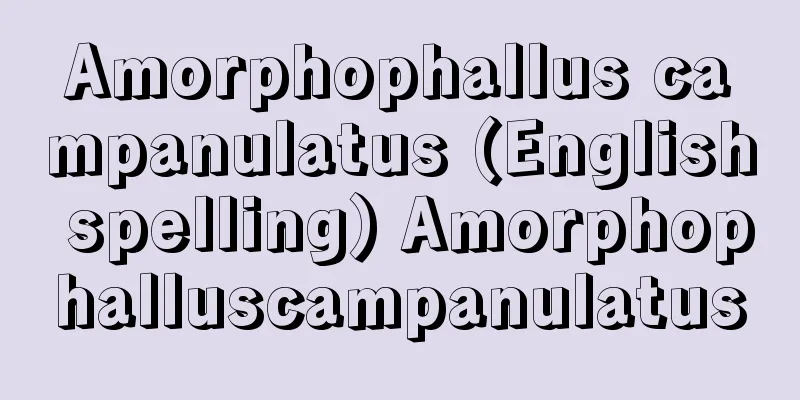Activated carbon - active carbon

|
A black carbonaceous material with strong adsorption capacity for dyes and gases. It is made of amorphous or microcrystalline carbon and is characterized by the development of pores with diameters of 50 nanometers or less. The volume of the pores is 0.6 to 0.8 cubic centimeters per gram. The internal surface area formed by the numerous pores is the largest of all porous materials. Some materials have an internal surface area of 500 to 1,500 square meters per gram. Activated carbon's ability to adsorb dyes and gases is due to the existence of such numerous pores and the fact that the internal surfaces form complex compounds in which oxygen, hydrogen, nitrogen, sulfur, halogens, etc. are bonded to carbon. One gram of activated carbon made from coconut shells can adsorb 2,000 milliliters of hydrogen at 0°C and 1 atmosphere. It is thought that the molecules to be adsorbed first pass through the relatively large pores of the activated carbon and are captured by the surfaces of the numerous pores with adsorption capacity of 2 nanometers or less. The distribution of pore sizes must be adjusted depending on what is to be adsorbed. In other words, activated carbon, which has large pores for large molecules such as dyes and many small pores for small molecules such as gases, is highly effective at adsorbing. Activated carbon is physically and chemically stable, resistant to acids and alkalis, and insoluble in various organic solvents. [Yuzo Sanada] Manufacturing methodIndustrially, it is produced from raw materials such as charcoal, wood, sawdust, coconut shells, pulp waste liquid, lignin, coals (lignite, brown coal, bituminous coal, anthracite), peat, pitch, petroleum coke, and cellulose. The manufacturing process involves firing the raw materials, followed by carbonization activation, and refining. Activation involves the oxidization and removal of hydrocarbons contained in pores of about 10 to 100 nanometers, and the selective burning of the internal carbon to create holes like holes and develop a porous structure. The product is available in powder and granular form. There are two activation methods: gas activation and chemical activation. In gas activation, charcoal, bituminous coal, and coke are fired and carbonized at about 600°C, and then activated by passing steam, carbon dioxide, air, etc. through them at 800 to 1000°C. For gas activation, the raw materials must be shaped in advance. Alumina, alumina chloride, or copper oxide may be sprinkled on the molded pieces to prevent them from sticking together. Chemical activation methods involve the use of zinc chloride, as well as chlorides of magnesium, tin, aluminum, calcium, quicklime, sulfuric acid, phosphoric acid, and sulfur dioxide, of which the zinc chloride method is the most widespread. In this method, raw materials that are easily dehydrated, such as peat and wood, are powdered and soaked in a concentrated aqueous solution of zinc chloride, phosphoric acid, etc., dried, and then fired and activated at 500-700°C at the same time, removing the carbohydrates in the raw materials in the form of water and obtaining highly active carbon. [Yuzo Sanada] ApplicationsPowdered activated carbon is often used in the liquid phase, for deodorization, decolorization, and purification in the oil, rubber, dye, sugar, and glutamic acid industries, and is generally disposable. Granular activated carbon is available in cylindrical and spherical shapes of 2 to 5 mm, and crushed carbon of 4 to 100 mesh (sieve size 4.760 to 0.149 mm). In addition to the same uses as powdered activated carbon, it is used in the gas phase for solvent recovery and the removal of toxic gases and dust. It is regenerated after adsorption for pollution prevention purposes such as water purification, domestic and industrial wastewater treatment, sewage treatment, and the removal of sulfur dioxide and nitrogen oxide from flue gas. Special activated carbon is also manufactured for catalyst carriers, molecular sieves, etc. [Yuzo Sanada] [Reference] |Source: Shogakukan Encyclopedia Nipponica About Encyclopedia Nipponica Information | Legend |
|
色素やガスなどに対して強い吸着能を有する黒色をした炭素質物質。無定形ないしは微結晶状の炭素からできており、直径が50ナノメートル以下の細孔の発達していることが特徴である。細孔の占める容積は1グラム当り0.6~0.8立方センチメートルにも及ぶ。多数の細孔が形成する内部表面積は、すべての多孔体物質中でももっとも大きい。1グラム当り500~1500平方メートルに達するものもある。活性炭が色素やガスを吸着する能力は、このような多数の細孔が存在し、かつその内部表面が、酸素、水素、窒素、硫黄(いおう)、ハロゲンなどが炭素と結合した錯化合物を形成しているからである。ヤシ殻からつくった活性炭1グラムは0℃、1気圧の水素を2000ミリリットルも吸着する。吸着される分子は、まず活性炭の比較的大きな孔(あな)の通路を通って、吸着能のある2ナノメートル以下の多数の細孔の表面に捕捉(ほそく)されると考えられる。どのようなものを吸着するかによって細孔径の分布を調整する必要がある。すなわち色素のように大きな分子のものは大きな細孔を、ガスのように小さい分子には小さな細孔を多く有する活性炭が吸着効果が大きい。活性炭は物理的にも化学的にも安定で、耐酸、耐アルカリ性で、各種有機溶剤にも不溶である。 [真田雄三] 製法工業的には木炭、木材、のこくず、ヤシ殻、パルプ廃液、リグニン、石炭類(亜炭、褐炭、瀝青炭(れきせいたん)、無煙炭)、泥炭(でいたん)、ピッチ、石油コークス、セルロースなどを原料として製造する。製法は、原料を焼成、炭化賦活(ふかつ)、精製の順に行う。賦活とは10~100ナノメートルぐらいの孔隙(こうげき)中に含まれる炭化水素の酸化除去、内部炭素の選択的燃焼により、虫食い状に孔をあけて孔隙構造を発達させることをいう。製品の形状として粉末状と粒状とがある。賦活法にはガス賦活法と薬品賦活法とがある。ガス賦活法は木炭、瀝青炭、コークスを600℃程度で焼成、炭化し、ついで水蒸気、炭酸ガス、空気などを800~1000℃で流してやり賦活する。ガス賦活には原料をあらかじめ成形しておく必要がある。成形物がくっつき合うのを防止するのにアルミナ、塩化アルミナ、酸化銅を散布することがある。薬品賦活法は塩化亜鉛のほかマグネシウム、スズ、アルミニウム、カルシウムなどの塩化物、生石灰、硫酸、リン酸、二酸化硫黄などを作用させる方法で、このうち塩化亜鉛法がもっとも普及している。泥炭、木材などの脱水されやすい原料を粉末にして塩化亜鉛、リン酸などの濃厚な水溶液をしみ込ませ、乾燥し、500~700℃で焼成と賦活を同時に行い、原料中の炭水化物を水の形で取り除き、活性の高い炭素を得る方法である。 [真田雄三] 用途粉末状活性炭は液相での使用が多く、油脂、ゴム、染料、砂糖、グルタミン酸工業で脱臭、脱色、精製用に用い、一般に使い捨てである。粒状活性炭は2~5ミリメートルの円筒形、球形のものと、4~100メッシュ(ふるい目の大きさ4.760~0.149ミリメートル)の破砕炭とがあり、粉状のものと同じ用途のほか、気相で溶剤回収、有毒ガス、粉塵(ふんじん)の除去に用いられる。浄水、家庭用や産業用の廃水処理、屎尿(しにょう)処理、排煙中の二酸化硫黄、酸化窒素などの除去など公害防止用には、吸着後再生使用する。このほか触媒担体、分子ふるいなど特殊な活性炭も製造されている。 [真田雄三] [参照項目] |出典 小学館 日本大百科全書(ニッポニカ)日本大百科全書(ニッポニカ)について 情報 | 凡例 |
<<: Active Center - Catalytic Center
Recommend
Numididae
…Flocks of guineafowl can travel tens of kilomete...
Calathea aloia - Calathea aloia
...There are also other beautiful species with li...
I Musici Chamber Orchestra - I Musici Chamber Orchestra
This chamber ensemble was formed in 1952 by musici...
Kugutentsuki - Kugutentsuki
... It is a weed that is distributed from tempera...
Integrated farming management - Fukugo nougyoukeiei
Agricultural management in which two or more busin...
Sangam
…It is also called Sangam literature. It is a col...
Emperor Picture (English)
This is the central theme of Chinese exhortation p...
Ball (medicine) - moxibustion
…The name medulla oblongata originally comes from...
New India Law - New India Law
...In addition, the 18th century saw a major shif...
Playful Nembutsu - Asobi Nembutsu
...On July 7th, graves are cleaned and bones are ...
Optic vesicle - Gampou
〘Noun〙 The part of a vertebrate embryo that will l...
Massufa
...The name Walata appears in the writings of Ita...
Yamanouchi [town] - Yamanouchi
A town in Shimotakai District, northeastern Nagano...
Welfare work - Fukushiroudou
When social welfare-related duties and practices a...
Yi Yi - Igei
…A heroic deity of Yi origin that appears in Chin...









